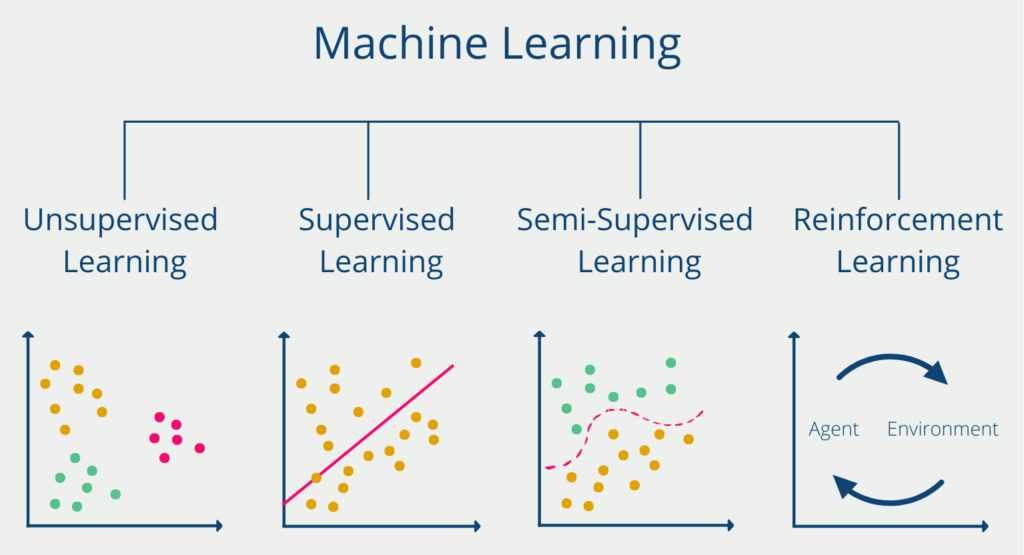Unsupervised learning refers to algorithms that recognize structures and patterns in a data set independently and without instruction. It is one of a total of four learning methods in machine learning. In practice, such models are used, for example, to assign data points to groups, so-called clusters.
How do you define Unsupervised Machine Learning?
Unsupervised Learning includes all artificial intelligence algorithms that recognize structures and groups in data that were not explicitly identified before. This includes, for example, clustering methods, such as k-Means clustering, or the reduction of the dimensionality of data, as is done in Principal Component Analysis.
Unsupervised Learning is also characterized by very little human interference, as the algorithm learns relationships with almost no input. In clustering, for example, the only human input is the number of cluster centers. This is why Unsupervised Learning is also referred to as Knowledge Discovery.
The difference with supervised learning is that the algorithm does not learn a predefined mapping of input data and predictions, but looks for interesting and statistical structures and dependencies in the data set on its own.
Unsupervised learning is popularly used when there is no grouped training data or it would be very difficult to obtain. However, this can be at the expense of other problems that arise when using Unsupervised Machine Learning. For example, there is no central metric that provides information about the quality of the model. With Supervised Machine Learning, we can use accuracy as a central metric to determine how often a model predicts the correct label.
This parameter is not available in Unsupervised Machine Learning, since there is no proper label. Therefore, the model must be tested with concrete examples and the quality of the model must be assessed based on this.
How does Unsupervised Learning work?
Artificial neural networks are primarily used for unsupervised learning. These are modeled on the biological structure of the brain. Each input signal passes through different layers of neurons, which process it according to learned rules. These networks are very well suited for processing complex tasks and for recognizing and learning correlations.
One process that takes place in this context is the so-called clustering. The goal is to assign data to a group without group assignment, i.e., without a label. For example, we might examine an image dataset with representations of dogs and cats. However, the images have no label, so nothing tells us which photo is a dog or a cat.

We would then train the Unsupervised Learning Algorithm to group the images into two clusters. In the training phase, the model must then identify how the image of a dog and a cat differ. This could be a starting point for the model to perform the grouping.
What are the applications of Unsupervised Machine Learning?
Unsupervised learning can be used in a wide variety of domains and new use cases are being added all the time. The data quality requirements are not high because we do not need labels in the training set as in supervised learning.
The following are the most popular applications for Unsupervised Learning:
- Customer segmentation in marketing: With the help of unsupervised learning, previously unrecognized relationships between customers can be used to divide them into groups that are as homogeneous as possible. These groupings can then be used to tailor an advertising campaign specifically to each group.
- Anomaly – detection: A bank processes several thousand money transfers a day. Therefore, fraudulent transfers can quickly get lost in the shuffle. Unsupervised learning makes it easier to detect such fraud attempts if suspicious transactions violate otherwise valid contexts.
- Shopping cart analyses in retail: Unsupervised learning can also be used to form so-called associations along the lines of “whoever buys x has also bought y afterward”.
- Speech processing: In the case of voice assistants, such as Siri or Alexa, these models recognize the habits and speech patterns of the user over time. This enables the devices to better respond to the user’s dialect or pronunciation.
Supervised and Unsupervised Machine Learning in Comparison
Let’s say we want to teach a child a new language, for example, English. If we do this according to the principle of supervised learning, we simply give him a dictionary with the English words and the translation into his native language, for example, German. The child will find it relatively easy to start learning and will probably be able to progress very quickly by memorizing the translations. Beyond that, however, he will have problems reading and understanding texts in English because he has only learned German-English translations and not the grammatical structure of sentences in English.
According to the principle of unsupervised learning, the scenario would look completely different. We would simply present the child with five English books, for example, and he would have to learn everything else on his own. This is, of course, a much more complex task. With the help of the “data,” the child could, for example, recognize that the word “I” occurs relatively frequently in texts and in many cases also appears at the beginning of a sentence, and draw conclusions from this.
This example also illustrates the differences between supervised and unsupervised learning. Supervised learning is in many cases a simpler algorithm and therefore usually has shorter training times. However, the model only learns contexts that are explicitly present in the training data set and were given as input to the model. The child learning English, for example, will be able to translate individual German words into English relatively well, but will not have learned to read and understand English texts.

Unsupervised learning, on the other hand, faces a much more complex task, since it must recognize and learn structures independently. As a result, the training time and effort are also higher. The advantage, however, is that the trained model also recognizes contexts that were not explicitly taught to it. The child who has taught himself the English language with the help of five English novels can possibly read English texts, translate individual words into German and also understand English grammar.
What are the limitations of Unsupervised Learning?
Unsupervised learning, unlike supervised learning, doesn’t involve labeled data to make predictions. Instead, it involves finding patterns, relationships, and structure in the data to group and segment it into clusters, reduce its dimensionality, or identify anomalies. Despite its potential in discovering hidden insights in data, unsupervised learning has several challenges and limitations:
- Lack of a clear evaluation metric: In unsupervised learning, the objective is often unclear, and there is no clear evaluation metric to measure the model’s performance. Unlike supervised learning, where prediction accuracy is a widely accepted metric, unsupervised learning models are evaluated based on how well they can identify patterns, segment the data, or detect anomalies.
- Difficulty in selecting the right algorithm: There are several unsupervised learning algorithms, each with its strengths and weaknesses. Choosing the right algorithm that fits the problem at hand can be challenging. Moreover, unsupervised learning algorithms are sensitive to the choice of hyperparameters, and choosing the right hyperparameters can be difficult without extensive experimentation.
- Difficulty in interpreting the results: Unsupervised learning models often produce results that are difficult to interpret. Unlike supervised learning, where the model’s predictions can be explained in terms of its input features, the clusters produced by unsupervised learning models may not have a clear interpretation. This makes it challenging to draw meaningful insights from the results.
- Handling large datasets: Unsupervised learning algorithms can be computationally expensive, especially when dealing with large datasets. Moreover, some algorithms may not be scalable to handle massive datasets.
- Dealing with noise and outliers: Unsupervised learning models are sensitive to noise and outliers in the data. Outliers can significantly impact the clustering or anomaly detection results, leading to incorrect conclusions.
- Domain knowledge: Unsupervised learning models require domain knowledge to make sense of the results. Without prior knowledge of the problem domain, it can be challenging to interpret the results and draw meaningful insights.
- Lack of ground truth: Unsupervised learning models do not have a ground truth to compare their predictions against. This can make it challenging to validate the results and compare different models.
Despite these challenges, unsupervised learning has several promising applications in various fields such as image and text analysis, anomaly detection, clustering, and dimensionality reduction. As researchers and practitioners continue to develop more robust unsupervised learning algorithms, it is likely that the challenges and limitations of unsupervised learning will be addressed, making it an even more powerful tool for data analysis.
This is what you should take with you
- Unsupervised learning is a valuable technique for discovering patterns and structures in data without the need for explicit labeling.
- It has a wide range of applications in various fields, including natural language processing, image and speech recognition, and anomaly detection.
- However, unsupervised learning has its challenges and limitations, such as the difficulty in evaluating the quality of results and the reliance on the assumptions of the algorithms used.
- Despite these limitations, unsupervised learning continues to be an active area of research, and new techniques are being developed to address these challenges.
- With the increasing availability of large and complex data sets, the importance of unsupervised learning techniques is likely to grow in the future.
What is blockchain-based AI?
Discover the potential of Blockchain-Based AI in this insightful article on Artificial Intelligence and Distributed Ledger Technology.
What is Boosting?
Boosting: An ensemble technique to improve model performance. Learn boosting algorithms like AdaBoost, XGBoost & more in our article.
What is Feature Engineering?
Master the Art of Feature Engineering: Boost Model Performance and Accuracy with Data Transformations - Expert Tips and Techniques.
What are N-grams?
Unlocking NLP's Power: Explore n-grams in text analysis, language modeling, and more. Understand the significance of n-grams in NLP.
What is the No-Free-Lunch Theorem?
Unlocking No-Free-Lunch Theorem: Implications & Applications in ML & Optimization
What is Automated Data Labeling?
Unlock efficiency in machine learning with automated data labeling. Explore benefits, techniques, and tools for streamlined data preparation.
Other Articles on the Topic of Unsupervised Learning
- The experts at IBM have published an article on Unsupervised Learning with detailed explanations of the applications of this learning method.

Niklas Lang
I have been working as a machine learning engineer and software developer since 2020 and am passionate about the world of data, algorithms and software development. In addition to my work in the field, I teach at several German universities, including the IU International University of Applied Sciences and the Baden-Württemberg Cooperative State University, in the fields of data science, mathematics and business analytics.
My goal is to present complex topics such as statistics and machine learning in a way that makes them not only understandable, but also exciting and tangible. I combine practical experience from industry with sound theoretical foundations to prepare my students in the best possible way for the challenges of the data world.





